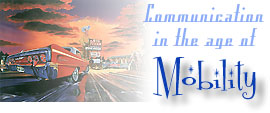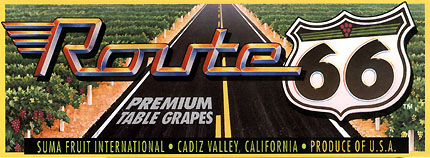
Office: HGH 210; phone: (408) 924-5378
Email: wooda@email.sjsu.edu
Web: http://www.sjsu.edu/faculty/wooda
 |
Dr. Andrew Wood Office: HGH 210; phone: (408) 924-5378 Email: wooda@email.sjsu.edu Web: http://www.sjsu.edu/faculty/wooda |
Introduction
: Course Calendar : Policies
: Readings
Assignments : Check Your Grades : Return
to Frontpage
Reading: Scott, Q. & Kelly, S.C. (1988). Route 66: The highway and its people. Normon, OK: University of Oklahoma Press.
Study guide: Focus on (1) dust bowl, (2) significant literature of the Depression, (3) architecture of the U-Drop Inn, impact of the Interstate on Route 66, (5) decade of Route 66's decommissioning.
 Quinta
Scott and Susan Croce Kelly tell the stories of Route 66 travelers heading West
- and the roadside business that sustained their journeys - in the twentieth
century. Many were spurred on by the Dust Bowl which decimated central states
and southwestern farming communities in the 1930s.
Quinta
Scott and Susan Croce Kelly tell the stories of Route 66 travelers heading West
- and the roadside business that sustained their journeys - in the twentieth
century. Many were spurred on by the Dust Bowl which decimated central states
and southwestern farming communities in the 1930s.
If you ever plan to motor west
travel my way, take the highway that's the best
Get your kicks on Route 66.
It winds from Chicago to L.A
more than two thousand miles all the way
Get your kicks on Route 66.
Well you go through Saint Looey
Joplin, Missouri; and Oklahoma City is mighty pretty
You'll see Amarillo; Gallup, New Mexico
Flagstaff, Arizona - don't forget Winona
Kingman, Barstow, San Bernardino
Won't you get hip to this timely tip
when you make that California trip
Get your kicks on Route 66.
Since then, literally hundreds of musicians, ranging from Manhattan Transfer to the Rolling Stones to Depeche Mode have produced versions of Route 66. By the 1960s, Route 66 had been even immortalized in a television show of the same name. But the interstate highway system that stitched the country so tightly together after the war spelled doom for the two lane highway. The age of mom and pop business owners who might be willing to wait for payment if a motorist had fallen on hard times rapidly came to a close. By the mid-1980s, the highway was finally decommissioned. Yet, even after losing its official status, people from around the world continue to seek out its heart. Using guidebooks, videos, and inspiration, they struggle to survive the winding turns, abrupt breaks, and lonely stretches of the "highway that's the best."

Activity
Select a brief prose piece about Route 66 and share an interpretative reading with your classroom colleagues. You might wish to consult my library on the subject, or go straight to two fine books with narratives of people who'd lived and traveled on the Mother Road: Michael Wallis' Route 66: The Mother Road or Tom Teague's Searching for 66. For your Show and Tell activity, summarize your piece and describe at least three interpretative choices you've chosen to make in your reading.
Supplemental Websites
California Historic Route 66 Association <http://www.wemweb.com/chr66a/>: "California's Route 66 is hard to beat as a travel theme for your next vacation. A pathway to California's history, cultural diversity, geology, geography and architecture, Route 66 in California reflects a significant part of our National Heritage."
National Historic Route 66 Federation <http://www.national66.com/>: "Visit the wonderful old trading posts, gas stations, motels, tourist traps, diners and villages along the scenic Mother Road"
Swa Frantzen's Historic Route 66 website <http://route66.netvision.be/>: "Where the Mother Road meets the Information Superhighway"
Traveling Historic Route 66 <http://www.travelinsurancereview.net/Travel-Facts/traveling-route-66.html>: Link recommended by Caitlyn Stewart